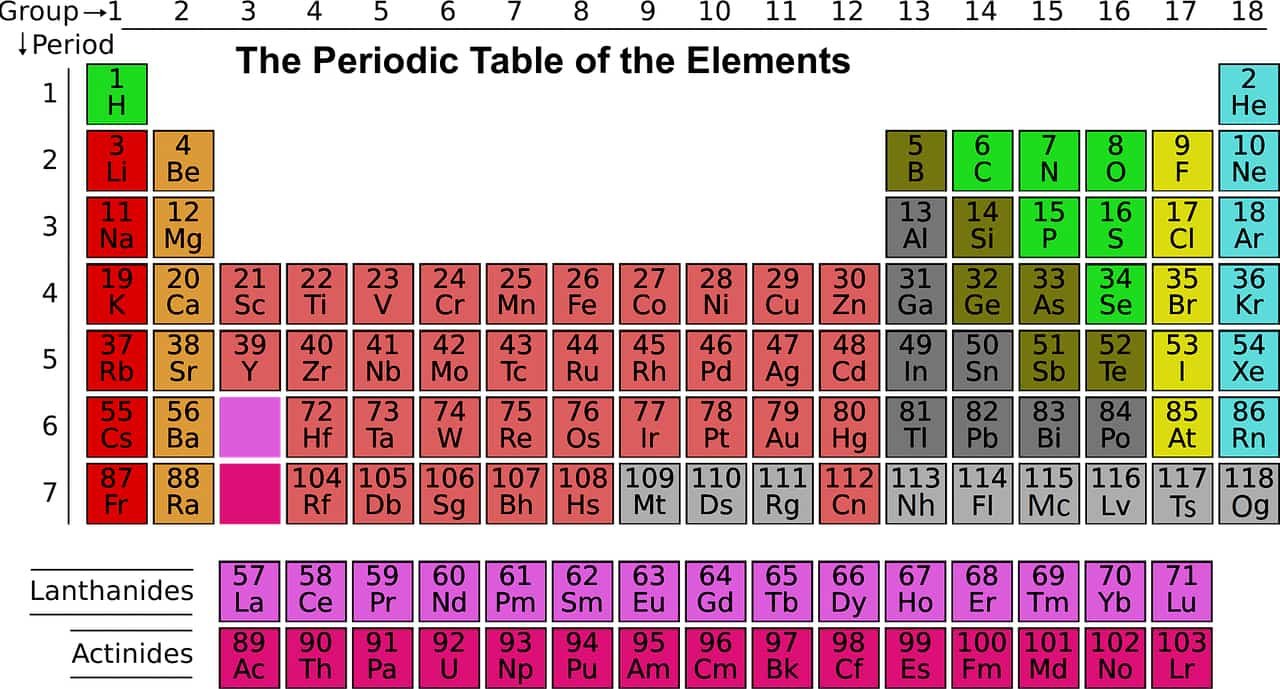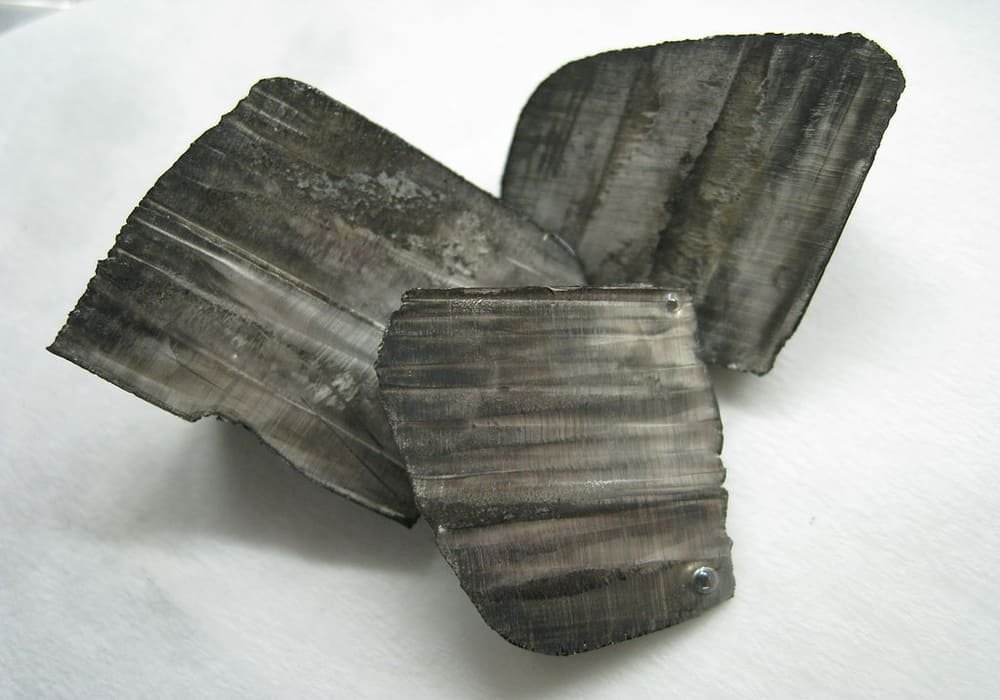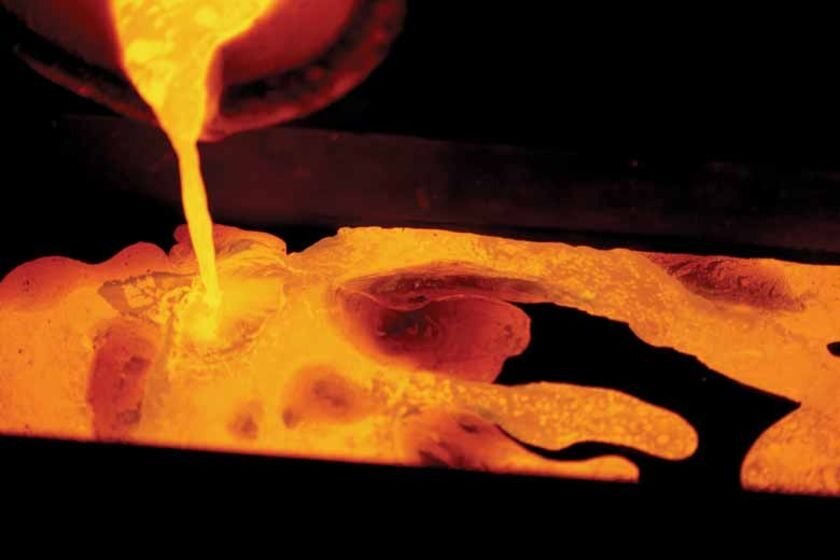Lithium is the chemical element with atomic number 3, symbol Li. It is an alkali metal, located in the first group of the periodic table of the elements.
The nuclei of the two stable isotopes of lithium (6Li and 7Li) are among the atomic nuclei with the lowest binding energy per nucleon of all stable isotopes, which means that these nuclei are in fact quite unstable compared to those other light elements. This is why they can be used in both nuclear fission and nuclear fusion reactions. This is also why lithium is less abundant in the solar system than 25 of the 32 lightest chemical elements. Its relative overabundance in nature compared to the predictions of only primordial and stellar nucleosyntheses is in fact explained by its interstellar nucleosynthesis (phenomenon of cosmic spallation) by bombardment of heavier elements by cosmic rays.
Lithium plays an important role in nuclear physics. Lithium is used for the production of tritium by the reaction: 6Li + n → 4He + 3H. In addition, lithium deuteride of formula 6Li2H is used as fuel for the H bomb.
Pure lithium is a soft metal, silvery gray in color, which tarnishes and oxidizes very quickly on contact with air and water, taking a dark gray tint quickly turning to anthracite and black. It is the lightest solid element. Like other alkali metals, metallic lithium readily reacts with air and with water. It is for this reason preserved in mineral oil to preserve it from the air.
Lithium is used to produce rechargeable or high voltage cells and batteries (65%), by the glass and ceramics industry (18%), special lubricants, the treatment of stale air with CO2, for example metallurgy and the rubber and thermoplastics industry, fine chemicals, alloy production.
Very reactive, it does not exist in the native state in the natural environment, but only in the form of ionic compounds. It is extracted from pegmatite-type rocks, as well as from clays and brines. The chemical element is used most often directly from mining concentrates. To obtain it industrially in the metallic state, the technique of molten salt electrolysis is used (55% LiCl and 45% KCl, at 400 °C.).
World lithium reserves were estimated by the USGS at 13 million tonnes at the end of 2010, of which 58% in Bolivia and 27% in China. By February 2020, this USGS estimate had increased to 17 million tonnes, and all identified resources to 80 million tonnes, including 26% in Bolivia, 21% in Argentina, 11% in Chile, 8% in Australia and 6% in China. Global production, for its part, amounted to 77,000 tonnes in 2019, excluding the United States (whose data are not made public by the USGS), ensured mainly by Australia (55%), the Chile (23%), China (10%) and Argentina (8%).
Lithium is present in traces in the oceans and in all living things. It does not seem to have a significant biological role because animals and plants can live in good health in an environment devoid of lithium. The possible non-vital functions of lithium have not been elucidated either, however the administration of Li+ ions in the form of lithium salts has been shown to be effective as a mood stabilizer, especially in cases of bipolar disorder.
Lithium in the periodic table
| Atomic number (Z) | 3 |
|---|---|
| Group | group 1: H and alkali metals |
| Period | period 2 |
| Block | s-block |
| Electron configuration | [He] 2s1 |
| Electrons per shell | 2, 1 |
Uses of Lithium
So much for the main uses of lithium in medicine, but be aware that more than 150 products containing lithium are used commercially. Lithium is used in the manufacture of various types of glasses, ceramics, lubricating greases, rubber, enamels, batteries and primary aluminum. It is also used in the chemical industry, in the manufacture of pharmaceuticals and certain alloys.
The lightest of the alkali metals (half as dense as water!) Was a strategic bomber material, and now essential for the development of electric vehicles.
Medicine
Lithium has long been used in the treatment of bipolar disorder. It remains the reference treatment with which the other mood stabilizers are compared. The active ingredient in lithium salts is the Li + ion, although the precise mechanisms of action are still debated. Lithium salts, such as lithium carbonate, lithium citrate or lithium orotate, are used as mood regulators for the treatment of bipolar disorder (formerly manic-depressive illness) 92,93.
However, this metal has a not insignificant nephrotoxicity, and it is necessary to carry out a renal assessment at the start of treatment and to assay the blood lithium monthly. Lithium is also used with certain antidepressants such as fluoxetine to treat obsessive-compulsive disorder.
Lithium gluconate is used in dermatology as an anti-allergenic and in the treatment of seborrheic dermatitis of the face in adults. Lithium is used in sleep disorders and irritability in oligotherapy (despite the lack of specifically demonstrated activity).
It is is mainly used in medicine for manic-depressive disorders, its main use, since it promotes sodium transport. This very disabling disease affects 1% of the population at some point in their life. It is characterized by euphoria or very marked depressions on the body, hyperactivity or even a decrease in sleep time leading to severe fatigue. It is a pathology with a hereditary tendency.
Lithium helps to regulate the appearance of manic-depressive disorders. If lithium is not enough to stop them, we use antidepressants. Lithium carries sodium through cell membranes with these disorders. The doses are between 600 and 1000 mg of lithium per day, which is necessary to obtain the proper blood level to treat the disease. Its acceptance in medicine was slow, however, because pharmaceutical institutes saw this solution as less profitable compared to synthetic drugs.
In the treatment of manic disorders, there is a fine line between the therapeutic and toxic levels. Since it is cleared in the urine, anyone with kidney disease should take lithium with caution. It is given in therapeutic doses only by prescription, with blood levels monitored closely by the doctor. People with the condition often have very good absorption of lithium, with excess lithium being excreted in the urine.
Lithium is believed to calm the nerves, encourage the mind, and soothe digestion, as described by its presence in some mineral waters.
The effect of lithium in inhaling tobacco does not present any particular dangers.
It is not yet clear what function, in particular, lithium plays in the body, it may be an essential nutrient. It is believed to be helpful in stabilizing the transmission of serotonin in the nervous system, influences sodium transport, and may even increase lymphocyte proliferation (white blood cells) and press suppressor cell activity, thereby enhancing the immune system. There is also speculation that lithium is somehow involved in cancer genesis or prevention.
It is also believed that lithium has sometimes been used in the treatment of alcoholism, where it appears to have decreased the taste of alcohol. However, this lithium treatment could produce side effects, such as a metallic taste in the mouth or increased thirst.
Pacemaker devices, or cardiac pacemakers, are used to allow the heart to contract more smoothly and more regularly. The main disadvantage of this system is the regular battery change. The pacemaker is powered by a lithium-ion battery, which has a long lifespan, which varies according to the number of cardiac stimulations.
Types of deposit
Lithium minerals (spodumene, petalite, lepidolite, amblygonite) are associated in particular with rocks such as granitic pegmatites with rare metals. These granitic pegmatites often constitute intrusive peraluminous complexes.
Rare metal pegmatites can be classified according to the geochemical signature of the accessory minerals, the internal structure of the rock and the pressure and temperature conditions of the crystallization of the minerals (Cerny, 1991).
This classification makes it possible to define five types of rare metal pegmatite:
- complex pegmatites;
- albite-spodumene pegmatites;
- albite pegmatites;
- rare earth pegmatites;
- beryl pegmatites.
Of these different types of pegmatite, only complex pegmatites and albite-spodumene pegmatites contain lithium minerals.
Complex pegmatites
Complex pegmatites exhibit a zonal arrangement of minerals. There are 4 subtypes:
- spodumene pegmatites;
- lepidolite pegmatites;
- petalite pegmatites;
- amblygonite pegmatites.
Physical properties
Properties of lithium
Metallic lithium is silvery white. It is a very reactive metal which reacts in particular with nitrogen. Its reaction with water is violent and dangerous. It is flammable. The temperature range where it is found in the liquid state is exceptionally wide. This metal is moderately abundant in the earth’s crust, less than nickel and copper. Many of its physical and chemical properties are more similar to those of the alkaline earth metals than to those of its own group. It is characterized by very high specific heat and thermal conductivity, low viscosity as well as low density. Metallic lithium is soluble in short chain aliphatic amines, such as ethylamine. In addition, it is insoluble with hydrocarbons.
| Physical properties | |
|---|---|
| Phase at STP | solid |
| Melting point | 453.65 K (180.50 °C, 356.90 °F) |
| Boiling point | 1603 K (1330 °C, 2426 °F) |
| Density (near r.t.) | 0.534 g/cm3 |
| when liquid (at m.p.) | 0.512 g/cm3 |
| Critical point | 3220 K, 67 MPa (extrapolated) |
| Heat of fusion | 3.00 kJ/mol |
| Heat of vaporization | 136 kJ/mol |
| Molar heat capacity | 24.860 J/(mol·K) |
Vapor pressure
| P (Pa) | 1 | 10 | 100 | 1 k | 10 k | 100 k |
|---|---|---|---|---|---|---|
| at T (K) | 797 | 885 | 995 | 1144 | 1337 | 1610 |
Atomic properties
| Atomic properties | |
|---|---|
| Oxidation states | +1 (a strongly basic oxide) |
| Electronegativity | Pauling scale: 0.98 |
| Ionization energies |
|
| Atomic radius | empirical: 152 pm |
| Covalent radius | 128±7 pm |
| Van der Waals radius | 182 pm |
Other properties
| Other properties | |
|---|---|
| Natural occurrence | primordial |
| Crystal structure | body-centered cubic (bcc) |
| Speed of sound thin rod | 6000 m/s (at 20 °C) |
| Thermal expansion | 46 µm/(m·K) (at 25 °C) |
| Thermal conductivity | 84.8 W/(m·K) |
| Electrical resistivity | 92.8 nΩ·m (at 20 °C) |
| Magnetic ordering | paramagnetic |
| Magnetic susceptibility | +14.2·10−6 cm3/mol (298 K)[1] |
| Young’s modulus | 4.9 GPa |
| Shear modulus | 4.2 GPa |
| Bulk modulus | 11 GPa |
| Mohs hardness | 0.6 |
| Brinell hardness | 5 MPa |
| CAS Number | 7439-93-2 |
History
| History | |
|---|---|
| Discovery | Johan August Arfwedson (1817) |
| First isolation | William Thomas Brande (1821) |
Main isotopes of lithium
| Main isotopes of lithium | ||||||||||||||||
|---|---|---|---|---|---|---|---|---|---|---|---|---|---|---|---|---|
| ||||||||||||||||
Periodic Table of Elements | Complete List of Chemical Elements by Group, Name, Symbol, Color and Type

Sources: Royal Society of Chemistry, Web MD, Live Science
Photo credit: Wikimedia Commons
Photo explanations: Pieces of lithium metals with a thin layer of black nitride tarnish.


